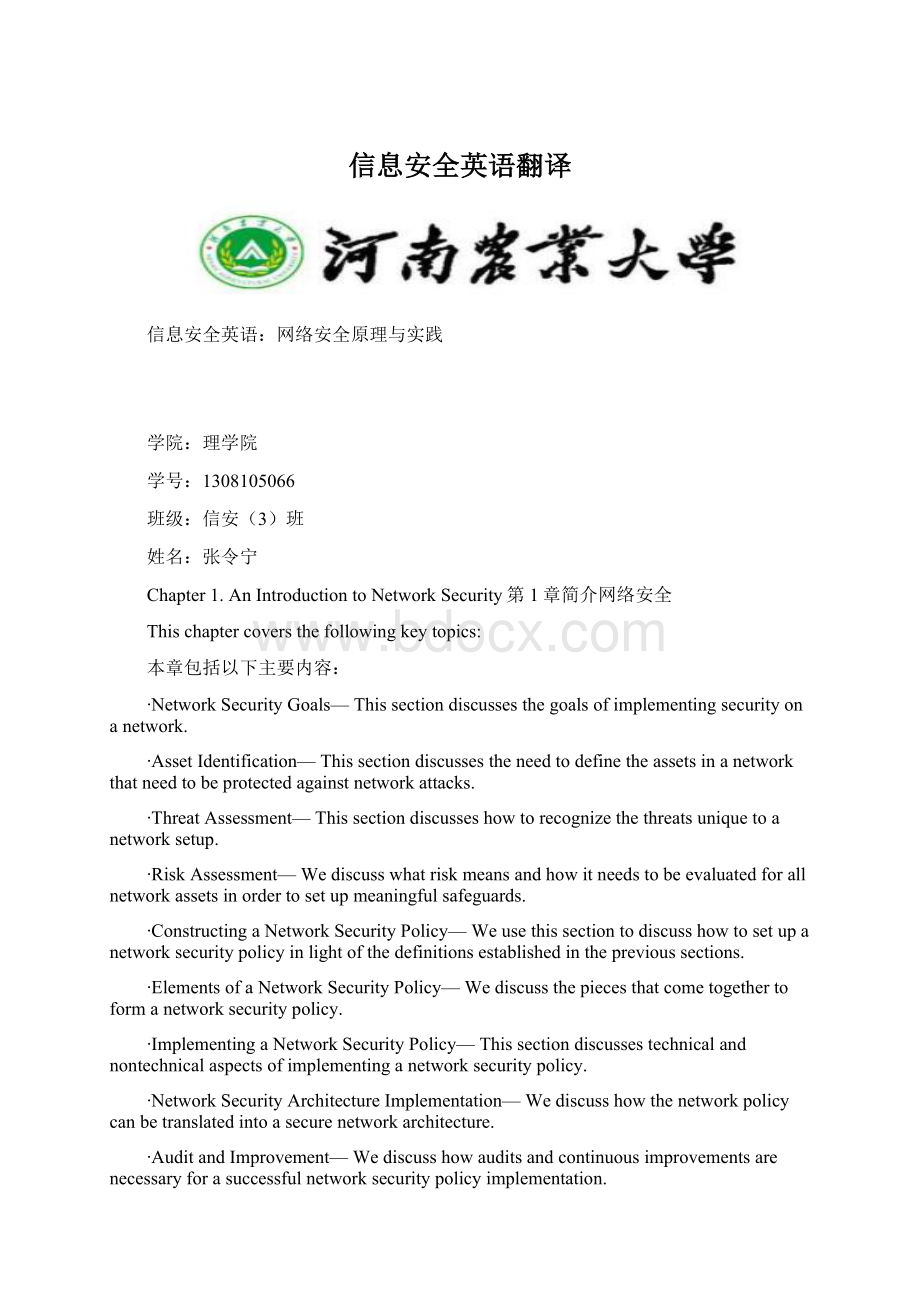信息安全英语翻译.docx
《信息安全英语翻译.docx》由会员分享,可在线阅读,更多相关《信息安全英语翻译.docx(12页珍藏版)》请在冰豆网上搜索。

信息安全英语翻译
信息安全英语:
网络安全原理与实践
学院:
理学院
学号:
1308105066
班级:
信安(3)班
姓名:
张令宁
Chapter1.AnIntroductiontoNetworkSecurity第1章简介网络安全
Thischaptercoversthefollowingkeytopics:
本章包括以下主要内容:
∙NetworkSecurityGoals—Thissectiondiscussesthegoalsofimplementingsecurityonanetwork.
∙AssetIdentification—Thissectiondiscussestheneedtodefinetheassetsinanetworkthatneedtobeprotectedagainstnetworkattacks.
∙ThreatAssessment—Thissectiondiscusseshowtorecognizethethreatsuniquetoanetworksetup.
∙RiskAssessment—Wediscusswhatriskmeansandhowitneedstobeevaluatedforallnetworkassetsinordertosetupmeaningfulsafeguards.
∙ConstructingaNetworkSecurityPolicy—Weusethissectiontodiscusshowtosetupanetworksecuritypolicyinlightofthedefinitionsestablishedintheprevioussections.
∙ElementsofaNetworkSecurityPolicy—Wediscussthepiecesthatcometogethertoformanetworksecuritypolicy.
∙ImplementingaNetworkSecurityPolicy—Thissectiondiscussestechnicalandnontechnicalaspectsofimplementinganetworksecuritypolicy.
∙NetworkSecurityArchitectureImplementation—Wediscusshowthenetworkpolicycanbetranslatedintoasecurenetworkarchitecture.
∙AuditandImprovement—Wediscusshowauditsandcontinuousimprovementsarenecessaryforasuccessfulnetworksecuritypolicyimplementation.
CaseStudy—Youseehowthetheoriesdiscussedinthischaptercanbeputintoeffectiveuse.
•网络安全Goals-本节讨论在网络上实现安全的目标。
•资产识别-本节讨论,需要在需要被保护,以防止网络攻击的网络定义的资产。
•威胁评估之本节讨论如何识别唯一的网络设置的威胁。
•风险评估之我们讨论什么风险的手段,以及如何需要它来为所有网络资产,以建立有意义的保障措施进行评估。
•构建网络安全政策制订我们使用本节讨论如何建立一个网络安全策略鉴于成立了上一节中的定义。
•网络安全政策制订的要素我们讨论走到一起,形成一个网络安全策略的作品。
•实施网络安全政策制订本节讨论实施网络安全策略的技术和非技术方面的问题。
•网络安全体系结构Implementation-我们讨论如何在网络策略可以被翻译成一个安全的网络架构。
•审计和Improvement-我们讨论审核和持续改进是如何需要一个成功的网络安全策略的实施。
•案例Study-您怎么看这一章中讨论的理论可以投入有效的使用。
Thischapterlaunchesthebookwithageneraldiscussionofdevelopingamotivationfornetworksecurity.Itaimstodevelopyourunderstandingofsomeofthecommonthreatsagainstwhichanetworkmustbeprotectedanddiscussesatahighlevelsomeofthecontrolsthatcanbeputintoplacetodefendagainsttheseattacks.Asecuritypolicyisthefoundationofallnetworksecurityimplementationsthatoccuronanygivennetwork.Itdefinesthescopeandmethodologyofthesecurityimplementations.Wewilldiscussthebasicprinciplesofsettingupameaningfulsecuritypolicyandhowitcanbeimplementedinanetworkenvironment.Thelatersectionsofthechapterdiscussthevalueofauditingthesecuritypolicyimplementationandhowitneedstobecontinuouslytestedandimproved.
本章开发一种动机网络安全的一般性讨论推出这本书。
它的目的是发展你的一些共同的威胁,对其中一个网络必须在高层次进行保护,并讨论一些可以到位,以对抗这些攻击的控件的理解。
安全策略是任何给定的网络上发生的所有网络安全的实现奠定了基础。
它定义了安全实现的范围和方法。
我们将讨论建立一个有意义的安全策略,以及它如何在网络环境中实现的基本原理。
本章的后面的章节讨论审核安全策略实施的价值以及它如何需要不断测试和改进。
NetworkSecurityGoals
网络安全目标
Networksecurityistheprocessthroughwhichanetworkissecuredagainstinternalandexternalthreatsofvariousforms.Inordertodevelopathoroughunderstandingofwhatnetworksecurityis,youmustunderstandthethreatsagainstwhichnetworksecurityaimstoprotectanetwork.Itisequallyimportanttodevelopahigh-levelunderstandingofthemainmechanismsthatcanbeputintoplacetothwarttheseattacks.
网络安全是通过该网络被固定以防止各种形式的内部和外部威胁的过程。
为了开发一个透彻地了解网络的安全性,必须了解其对网络安全的目的是保护网络中的威胁。
同样重要的是,开发了可以放入地方阻止这些攻击的主要机制的高级别理解。
Generally,theultimategoalofimplementingsecurityonanetworkisachievedbyfollowingaseriesofsteps,eachaimedatclarifyingtherelationshipbetweentheattacksandthemeasuresthatprotectagainstthem.Thefollowingisthegenerallyacceptedapproachtosettingupandimplementingsecurityonasite,assuggestedbyFites,etal.inControlandSecurityofComputerInformationSystems(M.Fites,P.Kratz,andA.Brebner,ComputerSciencePress,1989):
一般情况下,实现安全网络上的最终目标是通过以下一系列步骤实现的,每一个旨在澄清的攻击,并保护对他们采取的措施之间的关系。
下面是普遍接受的方法来建立和在网站上实现安全性,所建议的Fites,等人。
在控制计算机信息系统(M.Fites,P.克拉茨和A.布雷布纳,计算机科学出版社,1989年)的安全性:
Step1.Identifywhatyouaretryingtoprotect.
Step2.Determinewhatyouaretryingtoprotectitfrom.
Step3.Determinehowlikelythethreatsare.
Step4.Implementmeasuresthatprotectyourassetsinacost-effectivemanner.
Step5.Reviewtheprocesscontinuously,andmakeimprovementseachtimeyoufindaweakness.
步骤1:
识别你想保护什么。
步骤2.确定您要保护它的东西。
第3步:
确定威胁怎么可能是。
第4步实施的保护您的资产以具有成本效益的方式的措施。
第5步审查的过程中不断地,你会发现一个弱点,每次进行改进。
AssetIdentification
资产鉴定
Mostmodernnetworkshavemanyresourcesthatneedtobeprotected.Thereasonisthatmostenterprisestodayimplementnetworksystemstoprovideinformationtousersacrossthenetworkindigitalformatratherthaninanotherform,suchashardcopies.Therefore,thenumberofresourcesthatneedtobeprotectedincreasessignificantly.Thefollowinglist,bynomeanscomprehensive,identifiesnetworkresourcesthatneedtobeprotectedfromvarioustypesofattacks:
大多数现代网络具有需要被保护的资源。
其原因是,大多数企业目前实施的网络系统提供信息,以在整个网络中的用户的数字格式,而不是另一种形式,诸如硬拷贝。
因此,资源的需要的数量要显著保护增大。
下面的列表,并不全面,标识需要被保护,免受不同类型的攻击的网络资源:
∙Networkequipmentsuchasrouters,switches,andfirewalls
∙Networkoperationsinformationsuchasroutingtablesandaccesslistconfigurationsstoredonthisequipment
∙Intangiblenetworkingresourcessuchasbandwidthandspeed
∙Informationandtheinformationsourcesconnectedtothenetwork,suchasdatabasesandinformationservers
∙Endhostsconnectingtothenetworktomakeuseofvariousresources
∙Informationpassingacrossthenetworkatanygiventime
∙Theprivacyoftheusersasidentifiablethroughtheirusageofthenetworkresources
∙网络设备诸如路由器,交换机,防火墙和
∙网络运营信息,如存储在该设备的路由表和访问控制列表配置
∙无形的网络资源,如带宽和速度
∙连接到网络,如数据库和信息服务器的信息和信息来源,
∙连接到网络的终端主机利用各种资源
∙信息传递通过网络在任何给定时间
∙用户的通过的网络资源的使用量为可识别的隐私
∙所有这些因素都考虑在内的网络资产。
你需要通过制定和实施网络安全计划,以保护他们。
Allthesethingsareconsideredanetwork'sassets.Youneedtoprotectthembyformulatingandimplementinganetworksecurityplan.
ThreatAssessment
威胁评估
Networkattacksarewhatanetworksecurityprocessaimstoprotectitsnetworkassetsagainst.Networksecurityattacksareattempts,maliciousorotherwise,touseormodifytheresourcesavailablethroughanetworkinawaytheywerenotintendedtobeused.Inordertobetterunderstandwhatnetworkattacksare,itisagoodideatolookatthetypesofnetworkattacks.Networkattacksingeneralcanbedividedintothreemaincategories:
网络攻击是什么样的网络安全处理的目的是保护其网络资产反对。
网络安全攻击是企图,恶意的或其他方式,通过在某种程度上它们不旨在用于一个网络使用或修改现有的资源。
为了更好地了解网络攻击,这是看网络攻击的类型是个好主意。
在一般的网络攻击,可分为三大类:
∙Unauthorizedaccesstoresourcesorinformationthroughtheuseofanetwork
∙Unauthorizedmanipulationandalterationofinformationonanetwork
∙Denialofservice
∙通过使用网络的XX访问资源或信息
∙XX的操作和变更信息在网络上
∙拒绝服务
Chapter14,"WhatIsIntrusionDetection?
",offersamoredetailedexaminationofthevariouscategoriesofnetworkattacks.
第14章,“什么是入侵检测?
”,提供的各类网络攻击的更详细的检查。
Thekeywordtonoteinthefirsttwocategoriesofattacksisunauthorized.Anetworksecuritypolicydefineswhatisauthorizedandwhatisnot.However,ingeneralterms,unauthorizedaccessoccurswhenauserattemptstovieworalterinformationthatwasnotintendedforhisorherspecificuse.Insomesituationsitcanbefairlydifficulttodefinewhatwasintendedfortheuseofagivenuser.Therefore,itisimperativetohaveasecuritypolicyinplacethatisrestrictiveenoughtoclearlydefinealimitednumberofveryspecificresourcesandnetworkelementsthatausershouldbeallowedtogainaccessto.
关键的字记下前两类攻击是XX的。
网络安全策略定义了什么是授权的,哪些不是。
但是,总体而言,当用户试图查看或更改的目的不是为他或她的具体使用信息XX的访问发生。
在一些情况下,它可以是相当困难的定义什么是打算利用给定用户的。
因此,必须有一个安全策略的地方的是足以限制明确界定的非常具体的资源和网络元素使得用户应允许获得的数量有限。
Informationonanetworkcanbeeithertheinformationcontainedonenddevicesconnectedtothenetwork,suchaswebserversanddatabases;informationpassingthroughthenetwork;orinformationrelevanttotheworkingsofthenetworkingcomponents,suchastheroutingtablesandaccesscontrollistconfigurations.Resourcesonanetworkcaneitherbetheenddevices(networkcomponentssuchasroutersandfirewalls)ortheinterconnectmechanisms.
一个网络上的信息可以是包含在连接到网络的终端设备,诸如Web服务器和数据库中的信息;信息通过网络;或相关的网络组件,如路由表和访问控制列表的配置的运作信息。
一个网络上的资源可以是终端设备(网络组件,如路由器和防火墙)或互连机制。
Denialofserviceisoneofthemostcommontypesofnetworkattacks.Denialofserviceoccurswhenlegitimateaccesstoanetworkresourceisblockedordegradedbyamaliciousactoramistake.
拒绝服务是网络攻击的最常见的类型之一。
当合法访问网络资源被阻塞或恶意行为或错误发生降解拒绝服务。
Itisimportanttonotethatanetworksecurityattackcanbeintentionalorunintentional.Theaimofthesecuritymechanismsinanetworkisnotonlytoprotectagainstplannedandcoordinatedattacksconductedwithmaliciousintent,butalsotoprotectthenetworkanditsresourcesagainstmistakesmadebyusers.Thedamagescausedbyeithertypeofattackcanbesimilar.
要注意的是网络安全攻击可以是有意或无意的是重要的。
在网络中的安全机制的目的不仅是为了防止有恶意企图进行规划和协调的攻击,还能保护网络及其资源对用户所犯的错误。
造成两种类型的攻击所造成的损害可能是相似的。
Keepinginmindtheattacksjustoutlined,youcanstartbuildinganoutlineofthegoalsofimplementingnetworksecurityonanetwork.Theultimategoalistoprotectthenetworkagainsttheattacksjustdescribed.Therefore,anetworksecurityimplementationshouldaimtoachievethefollowinggoals:
牢记攻击刚才提到,您可以开始构建的网络上实现网络安全的目标的轮廓。
最终的目标是保护网络免受刚才所描述的攻击。
因此,网络安全的实现应力求实现以下目标:
∙Ascertaindataconfidentiality
∙Maintaindataintegrity
∙
∙Maintaindataavailability
∙探悉数据的保密性
∙维护数据的完整性
∙保持数据的可用性
RiskAssessment
风险评估
Havingidentifiedtheassetsandthefactorsthatthreatenthem,thenextstepinformulatinganetworksecurityimplementationistoascertainhowlikelythethreatsareintheenvironmentinwhichthesecurityisbeingimplemented.Realizethatalthoughitcanbeimportanttoprotectagainstalltypesofattacks,securitydoesnotcomecheap.Ther